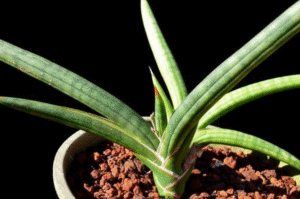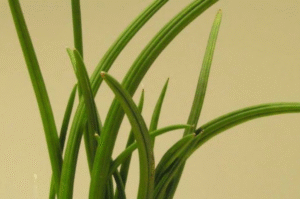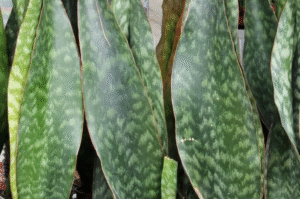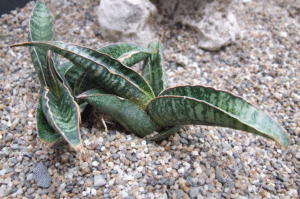If you’re hunting for a rare yet easy-to-grow houseplant that adds both elegance and practicality to your indoor space, Sansevieria gracilis deserves your attention. This slender, cylindrical-leaved variety stands out with its compact shape and low-maintenance care requirements. Whether you’re a beginner or a seasoned plant enthusiast, this guide will walk you through how to plant, grow, and care for Sansevieria gracilis from start to finish, with professional-level insights along the way.
Why Sansevieria gracilis Is a Unique Choice
Unlike the more common snake plant types with wide, sword-shaped leaves, Sansevieria gracilis has narrow, tubular foliage that grows in small rosettes. It’s a slow grower but makes a big impact in small spaces (ideal for desktops, windowsills, or minimalist interiors).
Quick Snapshot:
- Height: Usually grows 12–18 inches tall
- Leaves: Thin, upright, sometimes slightly curling
- Texture: Smooth and firm with subtle gray-green banding
- Growth Habit: Compact and non-spreading unless offsetting
- Toxicity: Mildly toxic to pets if ingested
With its sculptural shape and tidy growth pattern, Sansevieria gracilis makes an excellent ornamental plant without demanding too much attention.
Best Light Conditions for Sansevieria gracilis
This plant can survive in a variety of lighting environments, but for best results, provide bright, indirect light.
- Thrives in: East or west-facing windows
- Tolerates: Low-light areas like corners or office desks
- Avoid: Direct, harsh sun that can burn its narrow leaves
Although it tolerates low light, growth may slow significantly. If you notice leaves becoming pale or soft, it’s likely not getting enough light.
Ideal Soil and Pot Setup
Soil is the foundation of healthy growth. Choose or create a well-draining soil mix specifically for succulents or cacti. This helps avoid root rot, which is the top cause of death in this species.
DIY Soil Mix Recommendation:
- 2 parts cactus mix or well-aerated potting soil
- 1 part perlite or pumice
- 1 part coarse horticultural sand
Container Tips:
Opt for terracotta pots or ceramic containers with multiple drainage holes. Sansevieria gracilis does not like sitting in soggy soil, and these materials wick away excess moisture naturally.
Step-by-Step Guide: Planting Sansevieria gracilis
If you’re starting with a nursery plant or a propagated offset, planting it the right way helps establish healthy roots from day one.
You’ll Need:
- A small to medium pot with drainage
- Succulent/cactus soil mix
- Gloves (optional)
- Clean pruning shears (for trimming roots or dead leaves)
Instructions:
- Prep the Pot: Add a layer of stones or gravel at the bottom to improve drainage.
- Position the Plant: Place your Sansevieria gracilis in the pot, keeping the root ball centered.
- Fill with Soil: Backfill gently, pressing down lightly to stabilize the plant.
- Settle In: Let the plant adjust for 2–3 days before the first watering.
This short waiting period allows any disturbed roots to heal and reduces the risk of transplant shock or rot.
How to Maintain and Grow a Healthy Sansevieria gracilis
Sansevieria gracilis ranks high among plants that are hard to kill, but knowing a few key care strategies will help you enjoy its full potential.
Watering Routine
This plant prefers to be on the dry side. Think of it as a succulent in disguise.
- Spring/Summer: Water every 2–3 weeks
- Fall/Winter: Cut back to once every 4–6 weeks
Always let the soil dry completely before watering again. Too much water will cause the roots to rot quickly.
Temperature & Humidity
This plant prefers a moderate to warm indoor climate, ranging between 65°F and 85°F (18°C to 29°C).
- It handles low humidity just fine
- Avoid placing it in freezing or drafty locations
- If you live in a tropical climate, it can be grown outdoors in shaded areas
Fertilizer Tips
Fertilizing is optional, but it can support healthier foliage and root development.
- Use a diluted succulent fertilizer every 6–8 weeks in the growing season
- Avoid overfeeding, especially in fall and winter
Propagation Made Simple
Sansevieria gracilis is quite easy to propagate, a great way to share with friends or expand your collection.
Method 1: Division (Best for Beginners)
- Remove the plant from its pot
- Gently separate any offsets (baby plants) from the main root system
- Pot them individually using the same soil setup
Method 2: Leaf Cuttings
- Cut a healthy leaf into 2–3 inch segments
- Allow them to dry for 2–3 days until calloused
- Insert the base into moist soil and wait for roots to develop (this may take weeks)
Propagation via cuttings is slower but very rewarding if you’re patient.
Solving Common Sansevieria gracilis Issues
Like any plant, Sansevieria gracilis may show signs of stress from time to time. Here’s how to troubleshoot common issues:
| Issue | Symptoms | Fix |
| Too Much Water | Yellowing or mushy leaves | Let the soil dry fully; trim the rotten parts |
| Too Little Water | Wrinkled or shriveled leaves | Gradually resume watering |
| Root Rot | Bad smell, blackened roots | Repot immediately with fresh, dry soil |
| Pests | White fuzz or tiny webbing | Treat with neem oil or insecticidal soap |
| Sunburn | Brown, crispy edges | Move to indirect light immediately |
By catching these problems early, you can restore your plant’s health quickly and easily.
Decorative and Functional Uses Indoors
Sansevieria gracilis isn’t just functional, it’s a real design asset. Use it to add vertical texture and modern style to your home or office. Its tidy, upright leaves look especially striking when potted in matte ceramic or concrete planters.
Placement Ideas:
- Office desks or home workspaces
- Bathroom shelves with low light
- Coffee tables or windowsills
- Grouped with other succulents for contrast
Bonus: Like other snake plants, it may help improve indoor air quality by filtering toxins.
Is Sansevieria gracilis a Good Plant for You?
Let’s break it down — no fluff, just facts.
Advantages:
- Requires very little water
- Compact and easy to fit in small spaces
- Tolerates a wide range of light conditions
- Rare and attractive leaf shape
- Simple to propagate and share
Drawbacks:
- Grows slowly
- It can be hard to find in mainstream garden centers
- Sensitive to cold and overwatering
If you’re looking for a low-maintenance plant that looks high-end, this is an excellent choice. It’s also perfect for those who want something different from the usual varieties.
Conclusion
Sansevieria gracilis might not be as widely known as its cousins, but it holds its own with elegance, simplicity, and durability. It offers all the classic snake plant benefits (drought tolerance, ease of care, and air purification) with a sleeker, more refined look. Whether you’re curating a plant shelf, building a low-maintenance indoor jungle, or just want a beautiful green companion that won’t demand much, this graceful variety will not disappoint.






